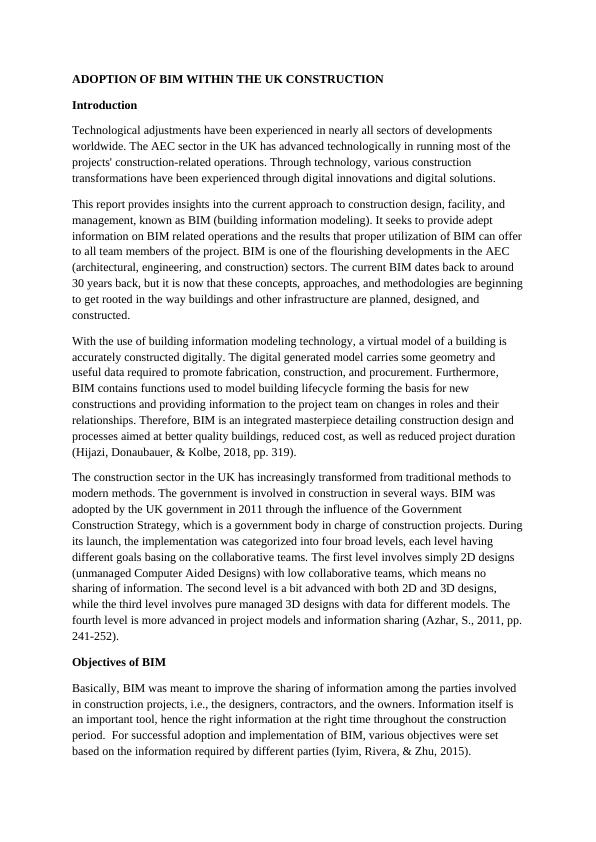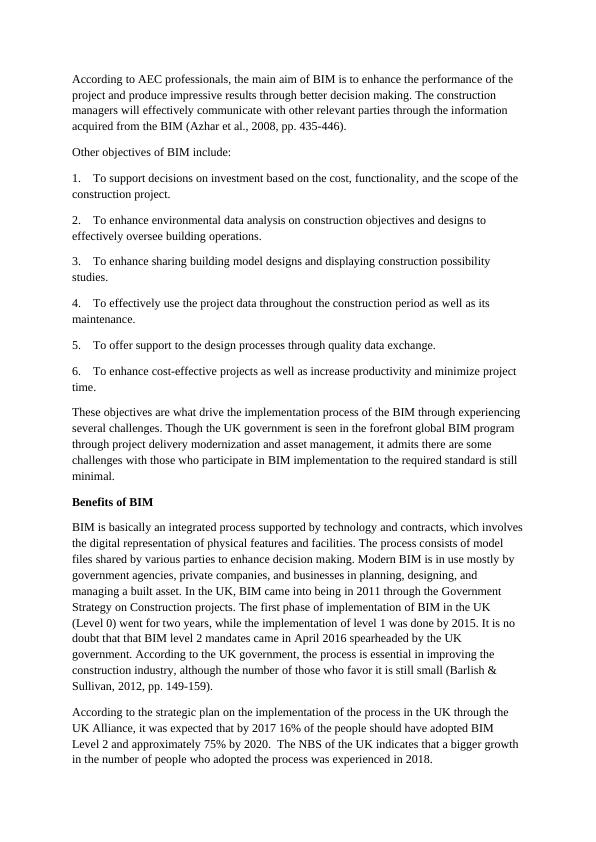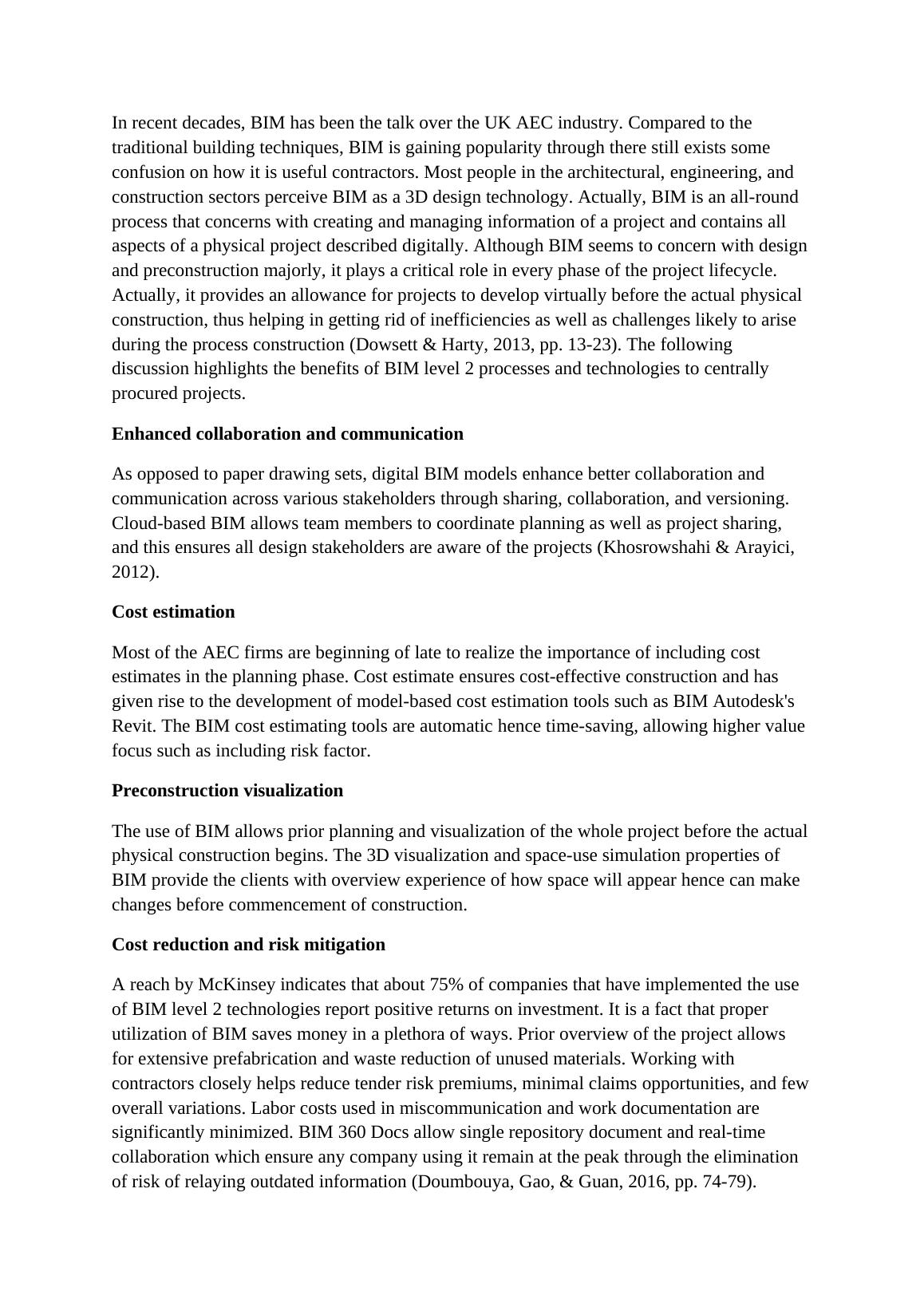Adoption of BIM Within the UK Construction Report 2022
Added on 2022-09-23
9 Pages4309 Words31 Views
ADOPTION OF BIM WITHIN THE UK CONSTRUCTION
Introduction
Technological adjustments have been experienced in nearly all sectors of developments
worldwide. The AEC sector in the UK has advanced technologically in running most of the
projects' construction-related operations. Through technology, various construction
transformations have been experienced through digital innovations and digital solutions.
This report provides insights into the current approach to construction design, facility, and
management, known as BIM (building information modeling). It seeks to provide adept
information on BIM related operations and the results that proper utilization of BIM can offer
to all team members of the project. BIM is one of the flourishing developments in the AEC
(architectural, engineering, and construction) sectors. The current BIM dates back to around
30 years back, but it is now that these concepts, approaches, and methodologies are beginning
to get rooted in the way buildings and other infrastructure are planned, designed, and
constructed.
With the use of building information modeling technology, a virtual model of a building is
accurately constructed digitally. The digital generated model carries some geometry and
useful data required to promote fabrication, construction, and procurement. Furthermore,
BIM contains functions used to model building lifecycle forming the basis for new
constructions and providing information to the project team on changes in roles and their
relationships. Therefore, BIM is an integrated masterpiece detailing construction design and
processes aimed at better quality buildings, reduced cost, as well as reduced project duration
(Hijazi, Donaubauer, & Kolbe, 2018, pp. 319).
The construction sector in the UK has increasingly transformed from traditional methods to
modern methods. The government is involved in construction in several ways. BIM was
adopted by the UK government in 2011 through the influence of the Government
Construction Strategy, which is a government body in charge of construction projects. During
its launch, the implementation was categorized into four broad levels, each level having
different goals basing on the collaborative teams. The first level involves simply 2D designs
(unmanaged Computer Aided Designs) with low collaborative teams, which means no
sharing of information. The second level is a bit advanced with both 2D and 3D designs,
while the third level involves pure managed 3D designs with data for different models. The
fourth level is more advanced in project models and information sharing (Azhar, S., 2011, pp.
241-252).
Objectives of BIM
Basically, BIM was meant to improve the sharing of information among the parties involved
in construction projects, i.e., the designers, contractors, and the owners. Information itself is
an important tool, hence the right information at the right time throughout the construction
period. For successful adoption and implementation of BIM, various objectives were set
based on the information required by different parties (Iyim, Rivera, & Zhu, 2015).
Introduction
Technological adjustments have been experienced in nearly all sectors of developments
worldwide. The AEC sector in the UK has advanced technologically in running most of the
projects' construction-related operations. Through technology, various construction
transformations have been experienced through digital innovations and digital solutions.
This report provides insights into the current approach to construction design, facility, and
management, known as BIM (building information modeling). It seeks to provide adept
information on BIM related operations and the results that proper utilization of BIM can offer
to all team members of the project. BIM is one of the flourishing developments in the AEC
(architectural, engineering, and construction) sectors. The current BIM dates back to around
30 years back, but it is now that these concepts, approaches, and methodologies are beginning
to get rooted in the way buildings and other infrastructure are planned, designed, and
constructed.
With the use of building information modeling technology, a virtual model of a building is
accurately constructed digitally. The digital generated model carries some geometry and
useful data required to promote fabrication, construction, and procurement. Furthermore,
BIM contains functions used to model building lifecycle forming the basis for new
constructions and providing information to the project team on changes in roles and their
relationships. Therefore, BIM is an integrated masterpiece detailing construction design and
processes aimed at better quality buildings, reduced cost, as well as reduced project duration
(Hijazi, Donaubauer, & Kolbe, 2018, pp. 319).
The construction sector in the UK has increasingly transformed from traditional methods to
modern methods. The government is involved in construction in several ways. BIM was
adopted by the UK government in 2011 through the influence of the Government
Construction Strategy, which is a government body in charge of construction projects. During
its launch, the implementation was categorized into four broad levels, each level having
different goals basing on the collaborative teams. The first level involves simply 2D designs
(unmanaged Computer Aided Designs) with low collaborative teams, which means no
sharing of information. The second level is a bit advanced with both 2D and 3D designs,
while the third level involves pure managed 3D designs with data for different models. The
fourth level is more advanced in project models and information sharing (Azhar, S., 2011, pp.
241-252).
Objectives of BIM
Basically, BIM was meant to improve the sharing of information among the parties involved
in construction projects, i.e., the designers, contractors, and the owners. Information itself is
an important tool, hence the right information at the right time throughout the construction
period. For successful adoption and implementation of BIM, various objectives were set
based on the information required by different parties (Iyim, Rivera, & Zhu, 2015).

According to AEC professionals, the main aim of BIM is to enhance the performance of the
project and produce impressive results through better decision making. The construction
managers will effectively communicate with other relevant parties through the information
acquired from the BIM (Azhar et al., 2008, pp. 435-446).
Other objectives of BIM include:
1. To support decisions on investment based on the cost, functionality, and the scope of the
construction project.
2. To enhance environmental data analysis on construction objectives and designs to
effectively oversee building operations.
3. To enhance sharing building model designs and displaying construction possibility
studies.
4. To effectively use the project data throughout the construction period as well as its
maintenance.
5. To offer support to the design processes through quality data exchange.
6. To enhance cost-effective projects as well as increase productivity and minimize project
time.
These objectives are what drive the implementation process of the BIM through experiencing
several challenges. Though the UK government is seen in the forefront global BIM program
through project delivery modernization and asset management, it admits there are some
challenges with those who participate in BIM implementation to the required standard is still
minimal.
Benefits of BIM
BIM is basically an integrated process supported by technology and contracts, which involves
the digital representation of physical features and facilities. The process consists of model
files shared by various parties to enhance decision making. Modern BIM is in use mostly by
government agencies, private companies, and businesses in planning, designing, and
managing a built asset. In the UK, BIM came into being in 2011 through the Government
Strategy on Construction projects. The first phase of implementation of BIM in the UK
(Level 0) went for two years, while the implementation of level 1 was done by 2015. It is no
doubt that that BIM level 2 mandates came in April 2016 spearheaded by the UK
government. According to the UK government, the process is essential in improving the
construction industry, although the number of those who favor it is still small (Barlish &
Sullivan, 2012, pp. 149-159).
According to the strategic plan on the implementation of the process in the UK through the
UK Alliance, it was expected that by 2017 16% of the people should have adopted BIM
Level 2 and approximately 75% by 2020. The NBS of the UK indicates that a bigger growth
in the number of people who adopted the process was experienced in 2018.
project and produce impressive results through better decision making. The construction
managers will effectively communicate with other relevant parties through the information
acquired from the BIM (Azhar et al., 2008, pp. 435-446).
Other objectives of BIM include:
1. To support decisions on investment based on the cost, functionality, and the scope of the
construction project.
2. To enhance environmental data analysis on construction objectives and designs to
effectively oversee building operations.
3. To enhance sharing building model designs and displaying construction possibility
studies.
4. To effectively use the project data throughout the construction period as well as its
maintenance.
5. To offer support to the design processes through quality data exchange.
6. To enhance cost-effective projects as well as increase productivity and minimize project
time.
These objectives are what drive the implementation process of the BIM through experiencing
several challenges. Though the UK government is seen in the forefront global BIM program
through project delivery modernization and asset management, it admits there are some
challenges with those who participate in BIM implementation to the required standard is still
minimal.
Benefits of BIM
BIM is basically an integrated process supported by technology and contracts, which involves
the digital representation of physical features and facilities. The process consists of model
files shared by various parties to enhance decision making. Modern BIM is in use mostly by
government agencies, private companies, and businesses in planning, designing, and
managing a built asset. In the UK, BIM came into being in 2011 through the Government
Strategy on Construction projects. The first phase of implementation of BIM in the UK
(Level 0) went for two years, while the implementation of level 1 was done by 2015. It is no
doubt that that BIM level 2 mandates came in April 2016 spearheaded by the UK
government. According to the UK government, the process is essential in improving the
construction industry, although the number of those who favor it is still small (Barlish &
Sullivan, 2012, pp. 149-159).
According to the strategic plan on the implementation of the process in the UK through the
UK Alliance, it was expected that by 2017 16% of the people should have adopted BIM
Level 2 and approximately 75% by 2020. The NBS of the UK indicates that a bigger growth
in the number of people who adopted the process was experienced in 2018.

In recent decades, BIM has been the talk over the UK AEC industry. Compared to the
traditional building techniques, BIM is gaining popularity through there still exists some
confusion on how it is useful contractors. Most people in the architectural, engineering, and
construction sectors perceive BIM as a 3D design technology. Actually, BIM is an all-round
process that concerns with creating and managing information of a project and contains all
aspects of a physical project described digitally. Although BIM seems to concern with design
and preconstruction majorly, it plays a critical role in every phase of the project lifecycle.
Actually, it provides an allowance for projects to develop virtually before the actual physical
construction, thus helping in getting rid of inefficiencies as well as challenges likely to arise
during the process construction (Dowsett & Harty, 2013, pp. 13-23). The following
discussion highlights the benefits of BIM level 2 processes and technologies to centrally
procured projects.
Enhanced collaboration and communication
As opposed to paper drawing sets, digital BIM models enhance better collaboration and
communication across various stakeholders through sharing, collaboration, and versioning.
Cloud-based BIM allows team members to coordinate planning as well as project sharing,
and this ensures all design stakeholders are aware of the projects (Khosrowshahi & Arayici,
2012).
Cost estimation
Most of the AEC firms are beginning of late to realize the importance of including cost
estimates in the planning phase. Cost estimate ensures cost-effective construction and has
given rise to the development of model-based cost estimation tools such as BIM Autodesk's
Revit. The BIM cost estimating tools are automatic hence time-saving, allowing higher value
focus such as including risk factor.
Preconstruction visualization
The use of BIM allows prior planning and visualization of the whole project before the actual
physical construction begins. The 3D visualization and space-use simulation properties of
BIM provide the clients with overview experience of how space will appear hence can make
changes before commencement of construction.
Cost reduction and risk mitigation
A reach by McKinsey indicates that about 75% of companies that have implemented the use
of BIM level 2 technologies report positive returns on investment. It is a fact that proper
utilization of BIM saves money in a plethora of ways. Prior overview of the project allows
for extensive prefabrication and waste reduction of unused materials. Working with
contractors closely helps reduce tender risk premiums, minimal claims opportunities, and few
overall variations. Labor costs used in miscommunication and work documentation are
significantly minimized. BIM 360 Docs allow single repository document and real-time
collaboration which ensure any company using it remain at the peak through the elimination
of risk of relaying outdated information (Doumbouya, Gao, & Guan, 2016, pp. 74-79).
traditional building techniques, BIM is gaining popularity through there still exists some
confusion on how it is useful contractors. Most people in the architectural, engineering, and
construction sectors perceive BIM as a 3D design technology. Actually, BIM is an all-round
process that concerns with creating and managing information of a project and contains all
aspects of a physical project described digitally. Although BIM seems to concern with design
and preconstruction majorly, it plays a critical role in every phase of the project lifecycle.
Actually, it provides an allowance for projects to develop virtually before the actual physical
construction, thus helping in getting rid of inefficiencies as well as challenges likely to arise
during the process construction (Dowsett & Harty, 2013, pp. 13-23). The following
discussion highlights the benefits of BIM level 2 processes and technologies to centrally
procured projects.
Enhanced collaboration and communication
As opposed to paper drawing sets, digital BIM models enhance better collaboration and
communication across various stakeholders through sharing, collaboration, and versioning.
Cloud-based BIM allows team members to coordinate planning as well as project sharing,
and this ensures all design stakeholders are aware of the projects (Khosrowshahi & Arayici,
2012).
Cost estimation
Most of the AEC firms are beginning of late to realize the importance of including cost
estimates in the planning phase. Cost estimate ensures cost-effective construction and has
given rise to the development of model-based cost estimation tools such as BIM Autodesk's
Revit. The BIM cost estimating tools are automatic hence time-saving, allowing higher value
focus such as including risk factor.
Preconstruction visualization
The use of BIM allows prior planning and visualization of the whole project before the actual
physical construction begins. The 3D visualization and space-use simulation properties of
BIM provide the clients with overview experience of how space will appear hence can make
changes before commencement of construction.
Cost reduction and risk mitigation
A reach by McKinsey indicates that about 75% of companies that have implemented the use
of BIM level 2 technologies report positive returns on investment. It is a fact that proper
utilization of BIM saves money in a plethora of ways. Prior overview of the project allows
for extensive prefabrication and waste reduction of unused materials. Working with
contractors closely helps reduce tender risk premiums, minimal claims opportunities, and few
overall variations. Labor costs used in miscommunication and work documentation are
significantly minimized. BIM 360 Docs allow single repository document and real-time
collaboration which ensure any company using it remain at the peak through the elimination
of risk of relaying outdated information (Doumbouya, Gao, & Guan, 2016, pp. 74-79).

End of preview
Want to access all the pages? Upload your documents or become a member.
Related Documents
KB7034: Building Information Modelling Managementlg...
|10
|2641
|405
Building Information Modelling (BIM): Now and Beyondlg...
|2
|517
|366
Building Information Modelling Management, Theory and Practicelg...
|2
|1976
|96
Key Risks and Challenges for Adopting BIM on Projectslg...
|7
|1545
|65
Integrated Project Delivery (IPD) Management Table of Contentslg...
|6
|951
|349
Impact of Building Information Modeling (BIM) on People Management Processes in Construction SMEslg...
|11
|3491
|70
